
🥳 AP BIO Chapter 12 - The Chromosomal Basis of Inheritance
Introduction -
12.1 Morgan showed that Mendelian inheritance has its physical basis in the behavior of chromosomes: scientific inquiry
12.2 Sex-linked genes exhibit unique patterns of inheritance
12.3 Linked genes tend to be inherited together because they are located near each other on the same chromosome
12.4 Alterations of chromosome number or structure cause some genetic disorders
BIG IDEAS: Segregation and independent assortment of linear chromosomes result in genetic variation (Big Idea 3), which is structural and functional evidence that supports the relatedness of all eukaryotes (Big Idea 1). The unique patterns of inheritance involving Barr bodies are produced by the interaction of RNA and the X chromosome (Big Idea 4)
Where in the cell are Mendel’s hereditary factors located?
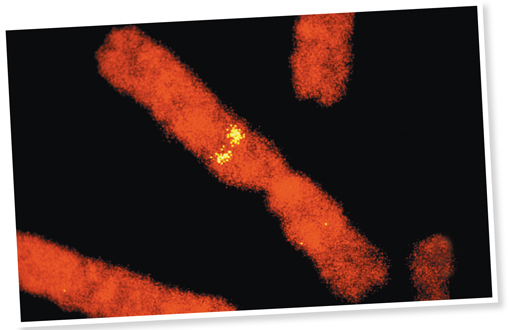
Chromosome Theory of Inheritance:
A basic principle in biology states that genes are located at specific loci on chromosomes and that the behavior of chromosomes during meiosis accounts for inheritance patterns
Loci:
Positions
Mendelian genes have specific loci (positions) along chromosomes, and it is the chromosomes that undergo ___
segregation and independent assortment
The chromosomal basis of Mendel’s laws - Here we correlate the results of one of Mendel’s dihybrid crosses (see Figure 11.8) with the behavior of chromosomes during meiosis (see Figure 10.8). The arrangement of chromosomes at metaphase I of meiosis and their movement during anaphase I account for, respectively, the independent assortment and segregation of the alleles for seed color and shape. Each cell that undergoes meiosis in an F1 plant produces two kinds of gametes. If we count the results for all cells, however, each F1 plant produces equal numbers of all four kinds of gametes because the alternative chromosome arrangements at metaphase I are equally likely
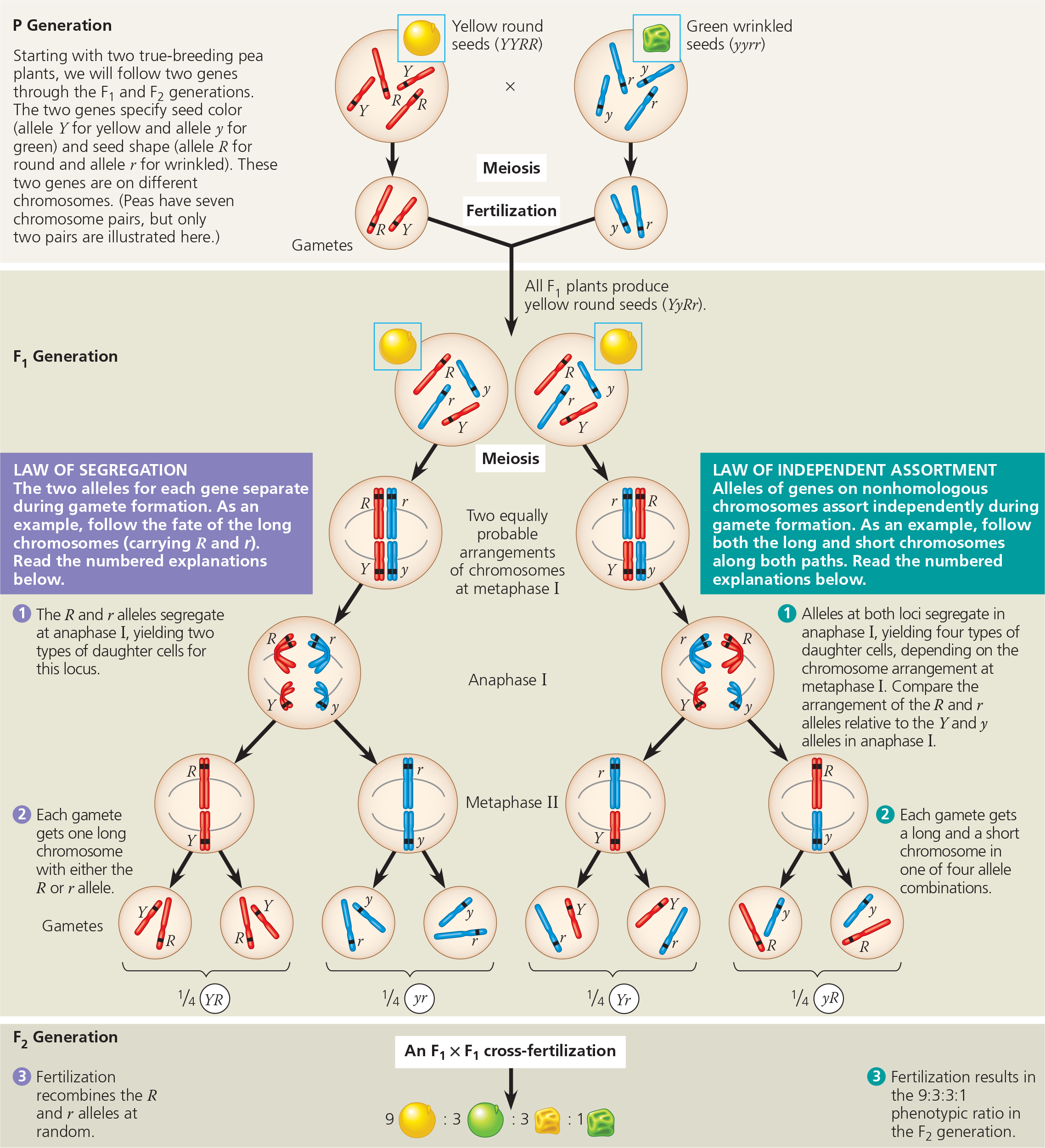
If you crossed an F1 plant with a plant that was homozygous recessive for both genes (yyrr), how would the phenotypic ratio of the offspring compare with the 9:3:3:1 ratio seen here?
The ratio would be 1 yellow round : 1 green round : 1 yellow wrinkled : 1 green wrinkled
Concept 12.1 - Morgan showed that Mendelian inheritance has its physical basis in the behavior of chromosomes: scientific inquiry
Morgan’s work with an eye-color gene in Drosophila led to the chromosome theory of inheritance, which states that genes are located on chromosomes and that the behavior of chromosomes during meiosis accounts for Mendel’s laws
Morgan’s discovery that transmission of the X chromosome in Drosophila correlates with the inheritance of an eye-color trait was the first solid evidence indicating that a specific gene is associated with a specific chromosome
Why did Morgan use fruit flies for his experiment?
There is a short time between generations and they have only four pairs of chromosomes, which are easily distinguishable with a light microscope
Wild Type:
The phenotype most commonly observed in natural populations; also refers to the individual with that phenotype
Mutant Phenotypes:
Alternatives to the wild type; due to alleles assumed to have originated as changes, or mutations, in the wild-type allele
Morgan’s First Mutant - Wild-type Drosophila flies have red eyes (left). Among his flies, Morgan discovered a mutant male with white eyes (right). This variation made it possible for Morgan to trace a gene for eye color to a specific chromosome (LMs)
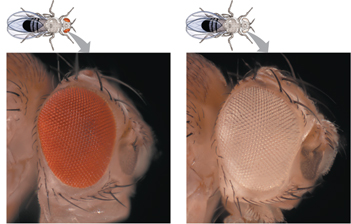
If the eye-color gene were unrelated to sex, half of the white-eyed flies would have been ___
female
Autosomal:
Not linked to sex chromosomes
The correlation between the trait of white eye color and the male sex of the affected F2 flies suggested to Morgan that the gene involved in his white-eyed mutant was located exclusively ___
on the X chromosome, with no corresponding allele present on the Y chromosome
Thomas Hunt Morgan wanted to analyze the behavior of two alleles of a fruit fly eye-color gene. In crosses similar to those done by Mendel with pea plants, Morgan and his colleagues mated a wild-type (red-eyed) female with a mutant white-eyed male

Morgan then bred an F1 red-eyed female to an F1 red-eyed male to produce the F2 generation. The F2 generation showed a typical Mendelian ratio of 3 red-eyed flies to 1 white-eyed fly. However, all white-eyed flies were males; no females displayed the white-eye trait

All F1 offspring had red eyes, so the mutant white-eye trait (w) must be recessive to the wild-type red-eye trait (w^+). Since the recessive trait—white eyes—was expressed only in males in the F2 generation, Morgan deduced that this eye-color gene is located on the X chromosome and that there is no corresponding locus on the Y chromosome
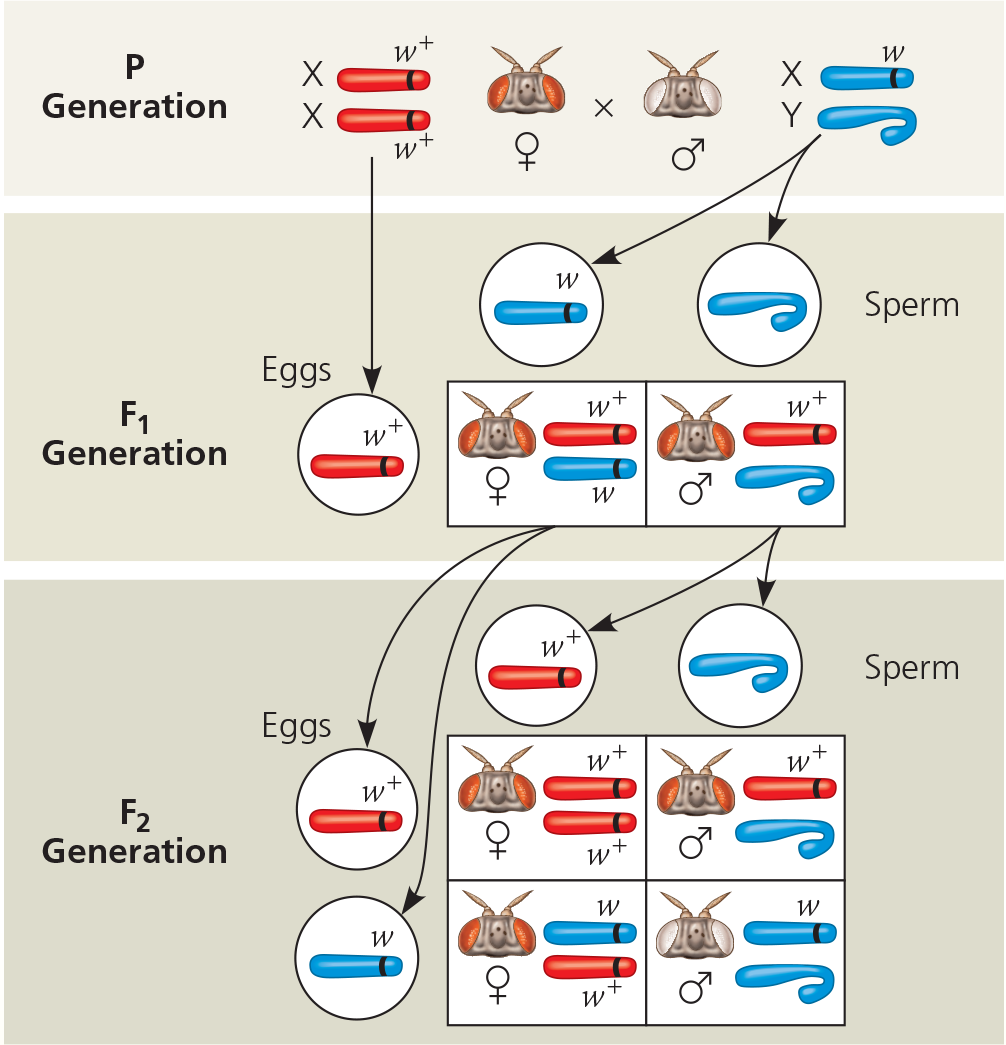
Suppose this eye-color gene were located on an autosome. Predict the phenotypes (including gender) of the F2 flies in this hypothetical cross
About ¾ of the F2 offspring would have red eyes and about . would have white eyes. About half of the white-eyed flies would be female and half would be male; similarly, about half of the red-eyed flies would be female and half would be male. (Note that the homologs with the eye-color alleles would be the same shape in the Punnett square, and each offspring would inherit two alleles. The sex of the flies would be determined separately by inheritance of the sex chromosomes. Thus your Punnett square would have four possible combinations in sperm and four in eggs; it would have 16 squares altogether.)
What did the correlation of traits and an individual’s sex prove?
It proved a specific gene is carried on a specific chromosome in this case, an eye-color gene on the X chromosome (supporting the chromosome theory of inheritance)
Which one of Mendel’s laws relates to the inheritance of alleles for a single character? Which law relates to the inheritance of alleles for two characters in a dihybrid cross?
The law of segregation relates to the inheritance of alleles for a single character. The law of independent assortment of alleles relates to the inheritance of alleles for two characters
Review the description of meiosis and Mendel’s laws of segregation and independent assortment. What is the physical basis for each of Mendel’s laws?
The physical basis for the law of segregation is the separation of homologs in anaphase I. The physical basis for the law of independent assortment is the alternative arrangements of all the different homologous chromosome pairs in metaphase I
Propose a possible reason that the first naturally occurring mutant fruit fly Morgan saw involved a gene on a sex chromosome and was found in a male
To show the mutant phenotype, a male needs to possess only one mutant allele. If this gene had been on a pair of autosomes, the two alleles would both have had to be mutant for an individual to show the recessive mutant phenotype, a much less probable situation
What characteristic of the sex chromosomes allowed Morgan to correlate their behavior with that of the alleles of the eye-color gene?
Because the sex chromosomes are different from each other and because they determine the sex of the offspring, Morgan could use the sex of the offspring as a phenotypic character to follow the parental chromosomes. (He could also have followed them under a microscope, as the X and Y chromosomes look different.) At the same time, he could record eye color to follow the eye-color alleles
Concept 12.2 - Sex-linked genes exhibit unique patterns of inheritance
Sex is often chromosomally based. Humans and other mammals have an X-Y system in which sex is determined by whether a Y chromosome is present
The sex chromosomes carry sex-linked genes, virtually all of which are on the X chromosome (X-linked). Any male who inherits a recessive X-linked allele (from his mother) will express the trait, such as color blindness
In mammalian females, one of the two X chromosomes in each cell is randomly inactivated during early embryonic development, becoming highly condensed into a Barr body
Short segments at either end of the Y chromosome are the only regions that are ___ with regions on the X
homologous
Human Sex Chromosomes
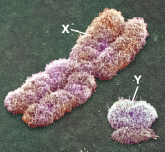
The mammalian X-Y chromosomal system of sex determination - In mammals, the sex of an offspring depends on whether the sperm cell contains an X chromosome or a Y. (All eggs have an X.) Numerals indicate the number of autosomes
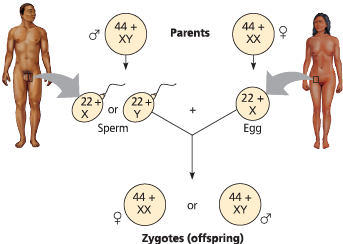
What happens as a result of sex chromosomes segregating during meiosis?
Each egg receives one X chromosome. In contrast, sperm fall into two categories: Half the sperm cells a male produces receive an X chromosome, and half receive a Y chromosome
SRY:
Gene on the Y chromosome required for the development of testes; sex-determining region of Y
Sex-Linked Gene:
A gene located on either chromosome. Most sex-linked genes are on the X chromosome and show distinctive patterns of inheritance
There are ___ genes on the Y chromosome
very few
Y-Linked Genes:
Genes located on the Y chromosome
X-Linked Genes:
Genes located on the X chromosome; such genes show a distinctive pattern of inheritance
If an X-linked trait is due to a recessive allele, a female will express the phenotype ___. Because males have only one locus, _
only if she is homozygous for that allele; any male receiving the recessive allele from his mother will express the trait
Hemizygous:
Having only one member of a chromosome pair or chromosome segment rather than the usual two
Since males have only one copy of each sex chromosome, they are hemizygous for all sex-linked genes, and they always ___
express the phenotype of the allele they get
Duchenne Muscular Dystrophy:
A human genetic disease caused by a sex-linked recessive allele; characterized by progressive weakening and a loss of muscle tissue (X-Linked)
The transmission of X-linked recessive traits - In this diagram, red-green color blindness is used as an example. The superscript N represents the dominant allele for normal color vision carried on the X chromosome, while n represents the recessive allele, which has a mutation causing color blindness. White boxes indicate unaffected individuals, light orange boxes indicate carriers, and dark orange boxes indicate color-blind individuals
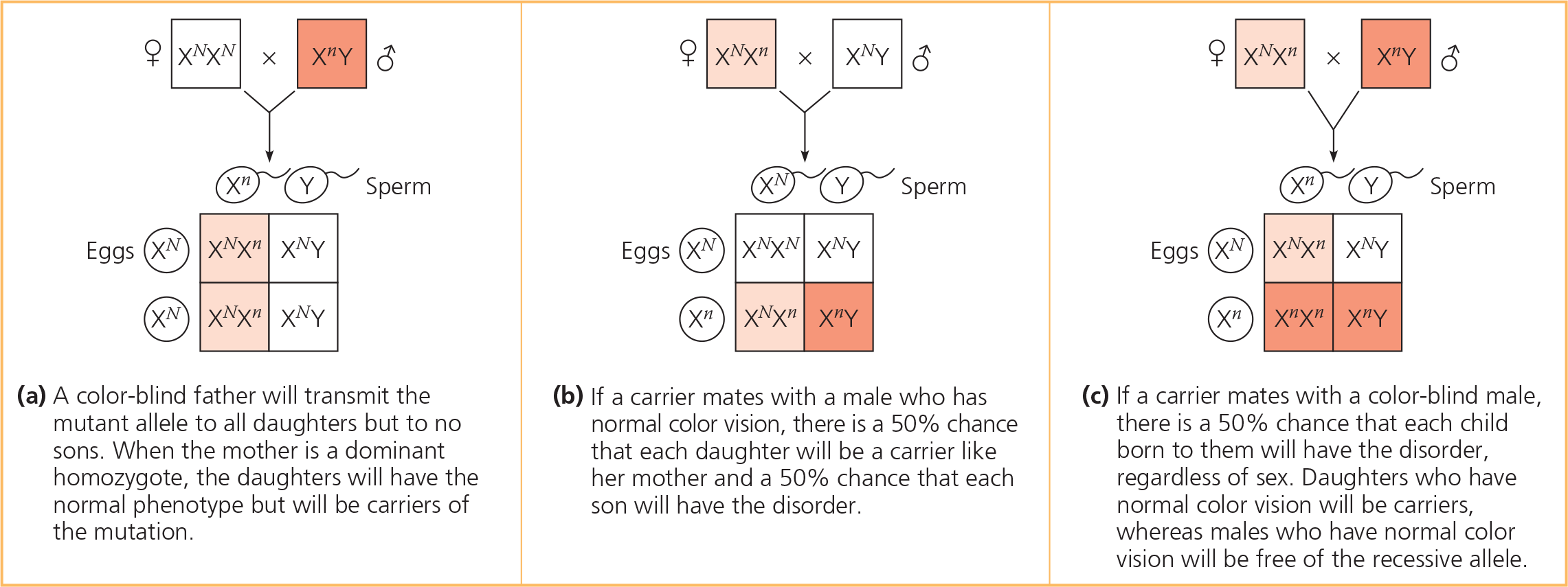
If a color-blind woman married a man who had normal color vision, what would be the probable phenotypes of their children?
All the males would be color-blind, and all the females would be carriers. (Another way to say this is that ½ the offspring would be color-blind males, and ½ the offspring would be carrier females.)
Hemophilia:
A human genetic disease caused by a sex-linked recessive allele, resulting in the absence of one or more blood-clotting roteins; characterized by excessive bleeding following injury (X-Linked)
Almost all of one X chromosome in each cell in female mammals becomes ___ during early embryonic development
inactivated
Barr Body:
A dense object lying along the inside of the nuclear envelope in cells of female mammals, representing a highly condensed, inactivated X chromosome
Barr-body chromosomes are ___ in the cells that give rise to eggs, resulting in every female gamete (egg) having an _ X after meiosis
reactivated; active
After an X chromosome is inactivated in a particular cell, all mitotic descendants of that cell have the same inactive X. Thus, if a female is heterozygous for a sex-linked trait, about ___ of her cells will express one allele, while the others will express the alternate allele
half
XIST:
Becomes active only on the chromosome that will become the Barr body; X-inactive specific transcript
X inactivation and the tortoiseshell cat - The tortoiseshell gene is on the X chromosome, and the tortoiseshell phenotype requires the presence of two different alleles, one for orange fur and one for black fur. Normally, only females can have both alleles, because only they have two X chromosomes. If a female cat is heterozygous for the tortoiseshell gene, she is tortoiseshell. Orange patches are formed by populations of cells in which the X chromosome with the orange allele is active; black patches have cells in which the X chromosome with the black allele is active. (“Calico” cats also have white areas, which are determined by yet another gene.)
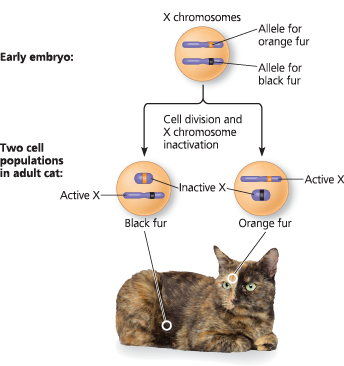
A white-eyed female Drosophila is mated with a red-eyed (wild-type) male. What phenotypes and genotypes do you predict for the offspring?
Because the gene for this eye-color character is located on the X chromosome, all female offspring will be red-eyed and heterozygous (X^w+ Xw); all male offspring will inherit a Y chromosome from the father and be white-eyed (X^w Y). (Another way to say this is that ½ the offspring will be red-eyed, heterozygous [carrier] females, and ½ will be white-eyed males.)
Neither Tim nor Rhoda has Duchenne muscular dystrophy, but their firstborn son does have it. What is the probability that a second child of this couple will have the disease? What is the probability if the second child is a boy? A girl?
¼ (½ chance that the child will inherit a Y chromosome from the father and be male × ½ chance that he will inherit the X carrying the disease allele from his mother); if the child is a boy, there is a ½ chance he will have the disease; a female would have zero chance (but ½ chance of being a carrier)
Consider what you learned about dominant and recessive alleles. If a disorder were caused by a dominant X-linked allele, how would the inheritance pattern differ from what we see for recessive X-linked disorders?
With a disorder caused by a dominant allele, there is no such thing as a “carrier,” since those with the allele have the disorder. Because the allele is dominant, the females lose any “advantage” in having two X chromosomes, since one disorder-associated allele is sufficient to result in the disorder. All fathers who have the dominant allele will pass it along to all their daughters, who will also have the disorder. A mother who has the allele (and thus the disorder) will pass it to half of her sons and half of her daughters
Why are males affected by X-linked disorders much more often than females?
Males have only one X chromosome, along with a Y chromosome, while females have two X chromosomes. The Y chromosome has very few genes on it, while the X has about 1,000. When a recessive X-linked allele that causes a disorder is inherited by a male on the X from his mother, there isn’t a second allele present on the Y (males are hemizygous), so the male has the disorder. Because females have two X chromosomes, they must inherit two recessive alleles in order to have the disorder, a rarer occurrence
Concept 12.3 - Linked genes tend to be inherited together because they are located near each other on the same chromosome
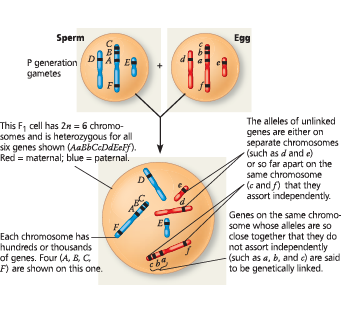
An F1 testcross yields parental types with the same combination of traits as those in the P generation parents and recombinant types with new combinations of traits. Unlinked genes exhibit a 50% frequency of recombination in the gametes. For genetically linked genes, crossing over accounts for the observed recombinants, always less than 50%
Recombination frequencies observed in genetic crosses allow construction of a linkage map (a type of genetic map)
Linked Genes:
Genes located close enough together on a chromosome that they tend to be inherited together
Morgan thus concluded that body color and wing size are usually inherited together in specific (parental) combinations because the genes for these characters are near each other on the same chromosome -
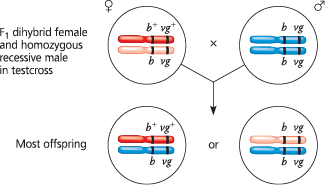
Genetic Recombination:
General term for the production of offspring with combinations of traits that differ from those found in either parent
Morgan wanted to know whether the genes for body color and wing size are genetically linked and, if so, how this affects their inheritance. The alleles for body color are b+ (gray) and b (black), and those for wing size are vg+ (normal) and vg (vestigial)
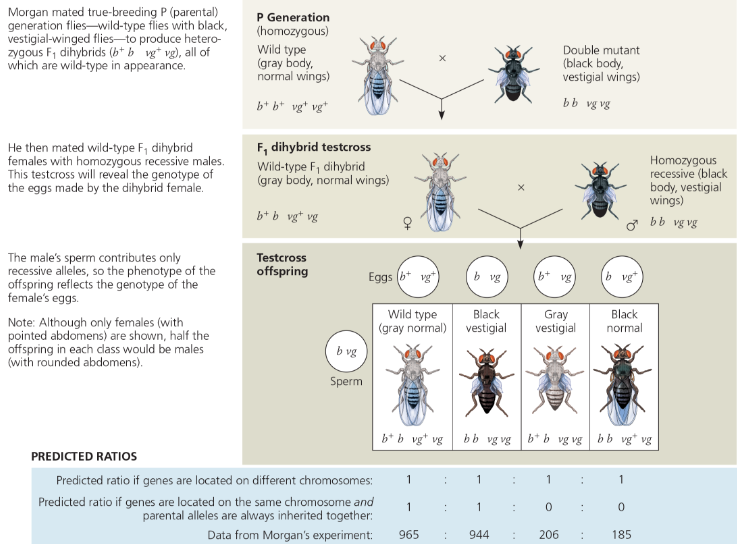
How does linkage between two genes affect inheritance of characters?
Since most offspring had a parental (P generation) phenotype, Morgan concluded that the genes for body color and wing size are genetically linked on the same chromosome. However, the production of a relatively small number of offspring with nonparental phenotypes indicated that some mechanism occasionally breaks the linkage between specific alleles of genes on the same chromosome
If the parental (P generation) flies had been true-breeding for gray body with vestigial wings and black body with normal wings, which phenotypic class(es) would be largest among the testcross offspring?
The two largest classes would still be the offspring with the phenotypes of the true-breeding P generation flies, but now they would be gray vestigial and black normal because those were the specific allele combinations in the P generation
Meiosis and random fertilization generate genetic variation among offspring of sexually reproducing organisms due to
independent assortment of chromosomes and crossing over in meiosis I and the possibility of any sperm fertilizing any egg
Consider a cross of a dihybrid pea plant with yellow round seeds, heterozygous for both seed color and seed shape (YyRr), with a plant homozygous for both recessive alleles (with green wrinkled seeds, yyrr)
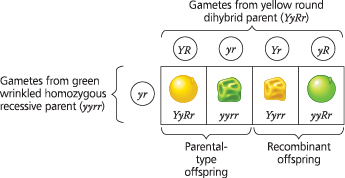
Parental Type:
An offspring with a phenotype that matches one of the true-breeding parental (P generation) phenotypes; also refers to the phenotype itself
Recombinant Type:
An offspring whose phenotype differs from that of the true-breeding P-generation parents; also refers to the phenotype itself
A 50% frequency of recombination in such test crosses is observed for any two genes that are located ___ and thus cannot be linked
on different chromosomes
he occurrence of parental types with a frequency greater than 50% indicates that the genes are ___
linked
Crossing Over:
The reciprocal exchange of genetic material between non-sister chromatids during prophase I of meiosis
In crossing over, which occurs while replicated homologous chromosomes are paired during prophase of meiosis I, a set of proteins orchestrates an exchange of ___
corresponding segments of one maternal and one paternal chromatid (see Figure 10.12)
Chromosomal basis for recombination of linked genes - In these diagrams re-creating the testcross in Figure 12.9, we track chromosomes as well as genes. The maternal chromosomes (present in the wild-type F1 dihybrid) are color-coded red and pink to distinguish one homolog from the other before any meiotic crossing over has occurred. Because crossing over between the b+/b and vg+/vg loci occurs in some, but not all, egg-producing cells, more eggs with parental-type chromosomes than with recombinant ones are produced in the mating females. Fertilization of the eggs by sperm of genotype b vg gives rise to some recombinant offspring. The recombination frequency is the percentage of recombinant flies in the total pool of offspring
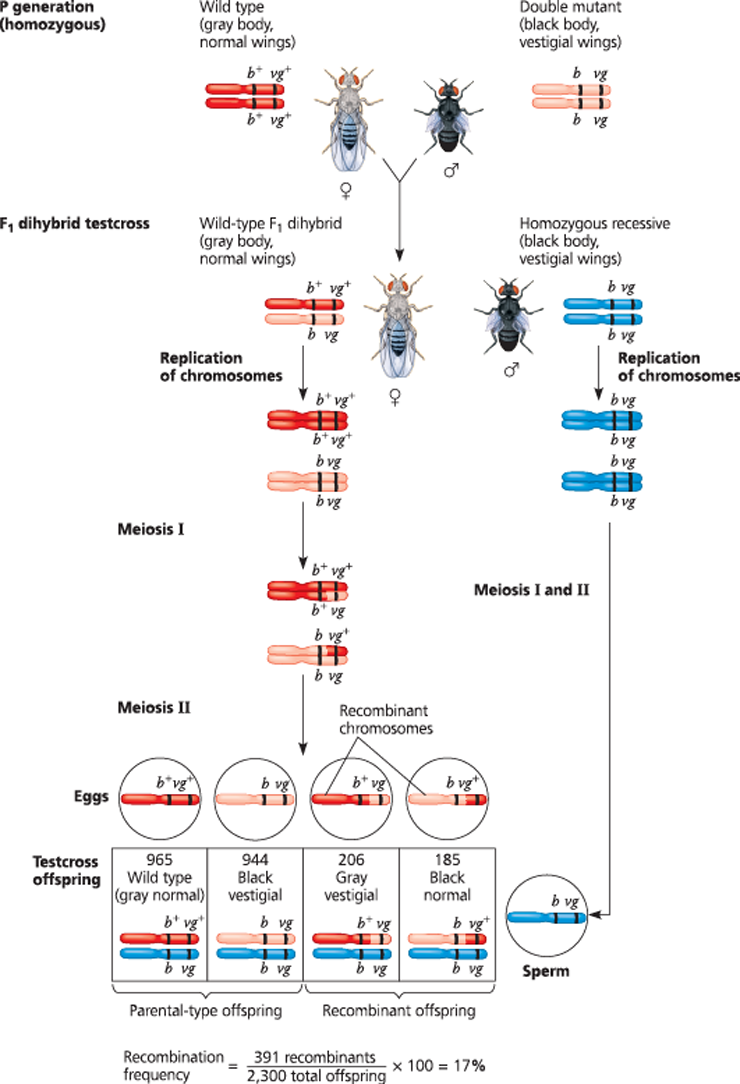
Suppose, as in the question at the bottom of Figure 12.9, the parental (P generation) flies were true-breeding for gray body with vestigial wings and black body with normal wings. Draw the chromosomes in each of the four possible kinds of eggs from an F1 female, and label each chromosome as “parental” or “recombinant.”
The two chromosomes below, left, are like the two chromosomes inherited by the F1 female, one from each P generation fly. They are passed by the F1 female intact to the offspring and thus could be called “parental” chromosomes. The other two chromosomes result from crossing over during meiosis in the F1 female. Because they have combinations of alleles not seen in either of the F1 female’s chromosomes, they can be called “recombinant” chromosomes. (Note that in this example, the alleles on the recombinant chromosomes, b+ vg+ and b vg, are the allele combinations that were on the parental chromosomes in the cross shown in Figures 12.9 and 12.10. The basis for calling them parental chromosomes is that they have the combination of alleles that was present on the P generation chromosomes.) 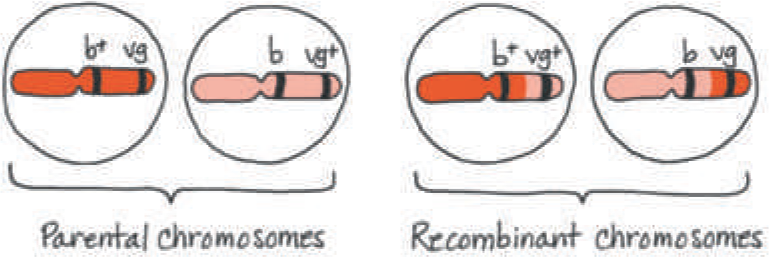
How can you tell if genes are linked or not?
If genes are unlinked and assorting independently, the phenotypic ratio of offspring from an F1 testcross is expected to be 1:1:1:1. If the two genes are linked, however, the observed phenotypic ratio of the offspring will not match that ratio
Chi-Square Test:
A statistical test to compare an observed data set with an expected data set determining the “goodness of fit“
Chri-Square Formula -
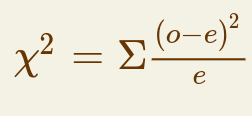
Genetic Map:
An ordered list of genetic loci (genes or other genetic markers) along a chromosome
What was Sturtevant’s prediction?
The farther apart two genes are, the higher the probability that a crossover will occur between them and therefore the higher the recombination frequency. His reasoning was simple: The greater the distance between two genes, the more points there are between them where crossing over can occur
Linkage Map:
A genetic map based on the frequencies of recombination between markers during the crossing over of homologous chromosomes
Map Unit:
A unit of measurement of the distance between genes. One map unit is equivalent to a 1% recombination frequency
Research Method
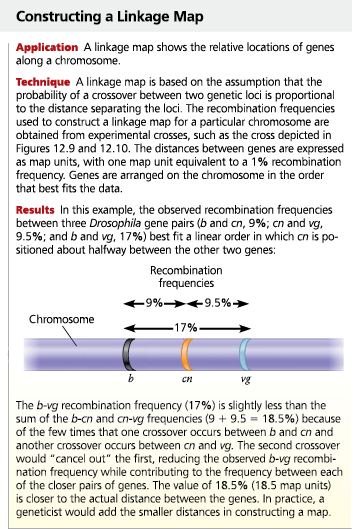
How are genes physically connected and genetically unlinked?
Despite being on the same chromosome, alleles of such genes assort independently, as if they were on different chromosomes
A partial genetic (linkage) map of a Drosophila chromosome - This simplified map shows just seven of the genes that have been mapped on Drosophila chromosome 2. (DNA sequencing has revealed over 9,000 genes on that chromosome.) The number at each gene locus indicates the number of map units between that locus and the locus for arista length (left). Notice that more than one gene can affect a given phenotypic character, such as eye color
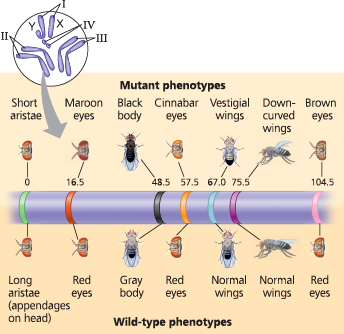
Cytogenetic Map:
A map of a chromosome that locates genes with respect to chromosomal features distinguishable in a microscope
When two genes are located on the same chromosome, what is the physical basis for the production of recombinant offspring in a testcross between a dihybrid parent and a double-mutant (recessive) parent?
Crossing over during meiosis I in the heterozygous parent produces some gametes with recombinant genotypes for the two genes. Offspring with a recombinant phenotype arise from fertilization of the recombinant gametes by homozygous recessive gametes from the double-mutant parent
For each type of offspring of the testcross in Figure 12.9, explain the relationship between its phenotype and the alleles contributed by the female parent. (It will be useful to draw out the chromosomes of each fly and follow the alleles throughout the cross.)
In each case, the alleles contributed by the female parent (in the egg) determine the phenotype of the offspring because the male in this cross contributes only recessive alleles. Thus, identifying the phenotype of the offspring tells you what alleles were in its mother’s (the dihybrid female’s) egg
Genes A, B, and C are located on the same chromosome. Test crosses show that the recombination frequency between A and B is 28% and that between A and C is 12%. Can you determine the linear order of these genes?
No. The order could be A-C-B or C-A-B. To determine which possibility is correct, you need to know the recombination frequency between B and C
Why are specific alleles of two distant genes more likely to show recombination than those of two closer genes?
Crossing over results in new combinations of alleles. Crossing over is a random occurrence, and the more distance there is between two genes, the more chances there are for crossing over to occur, leading to a new allele combination
Concept 12.4: Alterations of chromosome number or structure cause some genetic disorders
Aneuploidy, an abnormal chromosome number, results from nondisjunction during meiosis. When a normal gamete unites with one containing two copies or no copies of a particular chromosome, the resulting zygote and its descendant cells either have one extra copy of that chromosome (trisomy, 2n + 1) or are missing a copy (monosomy, 2n – 1). Polyploidy (extra sets of chromosomes) can result from complete nondisjunction
Chromosome breakage can result in alterations of chromosome structure: deletions, duplications, inversions, and translocations
Nondisjunction:
An error in meiosis or mitosis in which members of a pair of homologous chromosomes or sister chromatids fail to separate properly from each other
Meiotic nondisjunction - Gametes with an abnormal chromosome number can arise by nondisjunction in either meiosis I or meiosis II. For simplicity, the figure does not show the spores formed by meiosis in plants. Ultimately, spores form gametes that have the defects shown

Aneuploidy:
A chromosomal aberration in which one or more chromosomes are present in extra copies or are deficient in number
Monosomic:
Referring to a diploid cell that has only one copy of a particular chromosome instead of the normal two
Trisomic:
Referring to a diploid cell that has three copies of a particular chromosome instead of the normal two
Polyploidy:
A chromosomal alteration in which the organism possesses more than two complete chromosome sets. It is the result of an accident of cell division
the specific terms ___ indicate three and four chromosomal sets, respectively
triploid (3n) and tetraploidy (4n)
Deletion:
A deficiency in a chromosome resulting from the loss of a fragment through breakage; a mutational loss of one or more nucleotide pairs from a gene
The chromosome affected by deletion is then missing ___
certain genes
Duplication:
An aberration in chromosome structure due to fusion with a fragment from a homologous chromosome, such that a portion of a chromosome is duplicated
How is a duplication made?
The ‘deleted’ fragment may become attached as an extra segment to a sister chromatid, producing a duplication of a portion of that chromosome
What’s the result of a detached fragment attaching to a non-sister chromatid of a homologous chromosome?
The “duplicated” segments might not be identical because the homologs could carry different alleles of certain genes
Inversion:
An aberration in chromosome structure resulting from reattachment of a chromosomal fragment in a reverse orientation to the chromosome from which it origninted
Translocation:
An aberration in chromosome structure resulting from attachment of a chromosomal fragment to a nonhomologous chromosome; during protein synthesis, the third stage in the elongation cycle when the RNA carrying the growing polypeptide moves from the A site to the P site on the ribosome; the transport of rognci nutrients in the phloem of vascular plants
What results from a fragment reattaching to the original chromosome but in reverse orientation or joining a nonhomologous chromosome?
Inversion and translocation
Alterations of chromosome structure - Red arrows indicate breakage points. Dark purple highlights the chromosomal parts affected by the rearrangements
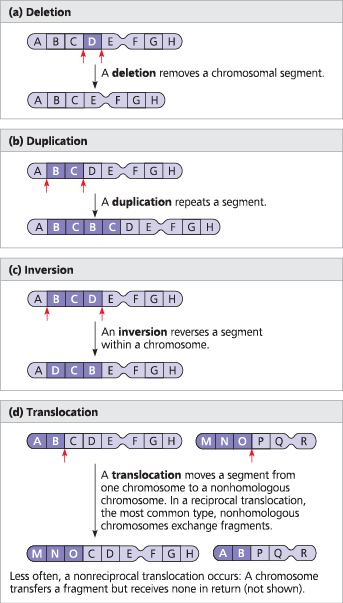
Why does deletion and duplication occur especially in meiosis?
In crossing over, nonsister chromatids sometimes exchange unequal-sized segments of DNA, so that one partner gives up more genes than it receives. The products of such an unequal crossover are one chromosome with a deletion and one chromosome with a duplication
Down Syndrome:
A human genetic disease usually cause by the presence ofan extra chromosome 21; characterized by developmental delays and heart and other defects that are generally treatable or non-life-threatening
What is trisomy 21?
Down syndrome
Down syndrome - The karyotype shows trisomy 21, the most common cause of Down syndrome. The child exhibits the facial features characteristic of this disorder
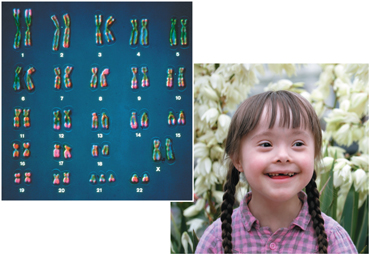
How do aneuploid conditions involving sex chromosomes appear to upset the genetic balance less than those involving autosomes?
The Y chromosome carries relatively few genes. Also, extra copies of the X chromosome simply become inactivated as Barr bodies in somatic cells
Klinefelter Syndrome:
When an extra X chromosome produces an XXY genotype in a male; characterized by male sex organs, being sterile, and some feminine characteristics
Describe females with trisomy (XXX)
They are healthy and have no unusual physical features other than being slightly taller than average. Triple-X females are at risk for learning disabilities but are fertile
Turner Syndrome:
The only known viable monosomy in humans; Although these X0 individuals are phenotypically female, they are sterile because their sex organs do not mature. When provided with estrogen replacement therapy, girls with Turner syndrome do develop secondary sex characteristics. Most have normal intelligence
Cri Du Chat:
Syndrome caused by specific deletion in chromosome 5; individuals with this are intellectually disabled, have a small head, have unusual facial features, have a cry of a distressed cat, and die early
Chronic Myelogenous Leukemia (CML):
This disease occurs when a reciprocal translocation happens during mitosis of pre-white blood cells. The exchange of a large portion of chromosome 22 with a small fragment from a tip of chromosome 9 produces a much shortened, easily recognized chromosome 22. Such an exchange causes cancer by creating a new “fused” gene that leads to uncontrolled cell cycle progression
Philadelphia Chromosome:
An abnormalty of chromosome 22 in which part of 9 is transferred to it
Translocation associated with chronic myelogenous leukemia (CML) - The cancerous cells in nearly all CML patients contain an abnormally short chromosome 22, the so-called Philadelphia chromosome, and an abnormally long chromosome 9. These altered chromosomes result from the reciprocal translocation shown here, which presumably occurred in a single white blood cell precursor undergoing mitosis and was then passed along to all descendant cells
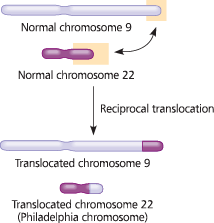
About 5% of individuals with Down syndrome have a chromosomal translocation in which a third copy of chromosome 21 is attached to chromosome 14. If this translocation occurred in a parent’s gonad, how could it lead to Down syndrome in a child?
In meiosis, a combined 14-21 chromosome will behave as one chromosome. If a gamete receives the combined 14-21 chromosome and a normal copy of chromosome 21, trisomy 21 will result when this gamete combines with a normal gamete during fertilization
The ABO blood type locus has been mapped on chromosome 9. A father who has type AB blood and a mother who has type O blood have a child with trisomy 9 and type A blood. Using this information, can you tell in which parent the nondisjunction occurred?
No. The child can be either IAIAi or IAii. A sperm of genotype IAIA could result from nondisjunction in the father during meiosis II, while an egg with the genotype ii could result from nondisjunction in the mother during either meiosis I or meiosis II
The gene that is activated on the Philadelphia chromosome codes for an intracellular kinase. Explain how the activation of this gene could contribute to the development of cancer
Activation of this gene could lead to the production of too much of this kinase. If the kinase is involved in a signaling pathway that triggers cell division, too much of it could trigger unrestricted cell division, which in turn could contribute to the development of a cancer (in this case, a cancer of one type of white blood cell)
Women born with an extra X chromosome (XXX) are generally healthy and indistinguishable in appearance from XX women. What is a likely explanation for this finding? How could you test this explanation?
The inactivation of two X chromosomes in XXX women would leave them with one genetically active X, as in women with the normal number of chromosomes. Microscopy should reveal two Barr bodies in XXX women
Why are inversions and reciprocal translocations less likely to be lethal than are aneuploidy, duplications, and deletions?
In inversions and reciprocal translocations, the same genetic material is present in the same relative amount but just organized differently. In aneuploidy, duplications, deletions, and nonreciprocal translocations, the balance of genetic material is upset, as large segments are either missing or present in more than one copy. Apparently, this type of imbalance is very damaging to the organism. (Although it isn’t lethal in the developing embryo, the reciprocal translocation that produces the Philadelphia chromosome can lead to a serious condition, cancer, by altering the expression of important genes.)
🥳 AP BIO Chapter 12 - The Chromosomal Basis of Inheritance
Introduction -
12.1 Morgan showed that Mendelian inheritance has its physical basis in the behavior of chromosomes: scientific inquiry
12.2 Sex-linked genes exhibit unique patterns of inheritance
12.3 Linked genes tend to be inherited together because they are located near each other on the same chromosome
12.4 Alterations of chromosome number or structure cause some genetic disorders
BIG IDEAS: Segregation and independent assortment of linear chromosomes result in genetic variation (Big Idea 3), which is structural and functional evidence that supports the relatedness of all eukaryotes (Big Idea 1). The unique patterns of inheritance involving Barr bodies are produced by the interaction of RNA and the X chromosome (Big Idea 4)
Where in the cell are Mendel’s hereditary factors located?

Chromosome Theory of Inheritance:
A basic principle in biology states that genes are located at specific loci on chromosomes and that the behavior of chromosomes during meiosis accounts for inheritance patterns
Loci:
Positions
Mendelian genes have specific loci (positions) along chromosomes, and it is the chromosomes that undergo ___
segregation and independent assortment
The chromosomal basis of Mendel’s laws - Here we correlate the results of one of Mendel’s dihybrid crosses (see Figure 11.8) with the behavior of chromosomes during meiosis (see Figure 10.8). The arrangement of chromosomes at metaphase I of meiosis and their movement during anaphase I account for, respectively, the independent assortment and segregation of the alleles for seed color and shape. Each cell that undergoes meiosis in an F1 plant produces two kinds of gametes. If we count the results for all cells, however, each F1 plant produces equal numbers of all four kinds of gametes because the alternative chromosome arrangements at metaphase I are equally likely

If you crossed an F1 plant with a plant that was homozygous recessive for both genes (yyrr), how would the phenotypic ratio of the offspring compare with the 9:3:3:1 ratio seen here?
The ratio would be 1 yellow round : 1 green round : 1 yellow wrinkled : 1 green wrinkled
Concept 12.1 - Morgan showed that Mendelian inheritance has its physical basis in the behavior of chromosomes: scientific inquiry
Morgan’s work with an eye-color gene in Drosophila led to the chromosome theory of inheritance, which states that genes are located on chromosomes and that the behavior of chromosomes during meiosis accounts for Mendel’s laws
Morgan’s discovery that transmission of the X chromosome in Drosophila correlates with the inheritance of an eye-color trait was the first solid evidence indicating that a specific gene is associated with a specific chromosome
Why did Morgan use fruit flies for his experiment?
There is a short time between generations and they have only four pairs of chromosomes, which are easily distinguishable with a light microscope
Wild Type:
The phenotype most commonly observed in natural populations; also refers to the individual with that phenotype
Mutant Phenotypes:
Alternatives to the wild type; due to alleles assumed to have originated as changes, or mutations, in the wild-type allele
Morgan’s First Mutant - Wild-type Drosophila flies have red eyes (left). Among his flies, Morgan discovered a mutant male with white eyes (right). This variation made it possible for Morgan to trace a gene for eye color to a specific chromosome (LMs)

If the eye-color gene were unrelated to sex, half of the white-eyed flies would have been ___
female
Autosomal:
Not linked to sex chromosomes
The correlation between the trait of white eye color and the male sex of the affected F2 flies suggested to Morgan that the gene involved in his white-eyed mutant was located exclusively ___
on the X chromosome, with no corresponding allele present on the Y chromosome
Thomas Hunt Morgan wanted to analyze the behavior of two alleles of a fruit fly eye-color gene. In crosses similar to those done by Mendel with pea plants, Morgan and his colleagues mated a wild-type (red-eyed) female with a mutant white-eyed male

Morgan then bred an F1 red-eyed female to an F1 red-eyed male to produce the F2 generation. The F2 generation showed a typical Mendelian ratio of 3 red-eyed flies to 1 white-eyed fly. However, all white-eyed flies were males; no females displayed the white-eye trait

All F1 offspring had red eyes, so the mutant white-eye trait (w) must be recessive to the wild-type red-eye trait (w^+). Since the recessive trait—white eyes—was expressed only in males in the F2 generation, Morgan deduced that this eye-color gene is located on the X chromosome and that there is no corresponding locus on the Y chromosome

Suppose this eye-color gene were located on an autosome. Predict the phenotypes (including gender) of the F2 flies in this hypothetical cross
About ¾ of the F2 offspring would have red eyes and about . would have white eyes. About half of the white-eyed flies would be female and half would be male; similarly, about half of the red-eyed flies would be female and half would be male. (Note that the homologs with the eye-color alleles would be the same shape in the Punnett square, and each offspring would inherit two alleles. The sex of the flies would be determined separately by inheritance of the sex chromosomes. Thus your Punnett square would have four possible combinations in sperm and four in eggs; it would have 16 squares altogether.)
What did the correlation of traits and an individual’s sex prove?
It proved a specific gene is carried on a specific chromosome in this case, an eye-color gene on the X chromosome (supporting the chromosome theory of inheritance)
Which one of Mendel’s laws relates to the inheritance of alleles for a single character? Which law relates to the inheritance of alleles for two characters in a dihybrid cross?
The law of segregation relates to the inheritance of alleles for a single character. The law of independent assortment of alleles relates to the inheritance of alleles for two characters
Review the description of meiosis and Mendel’s laws of segregation and independent assortment. What is the physical basis for each of Mendel’s laws?
The physical basis for the law of segregation is the separation of homologs in anaphase I. The physical basis for the law of independent assortment is the alternative arrangements of all the different homologous chromosome pairs in metaphase I
Propose a possible reason that the first naturally occurring mutant fruit fly Morgan saw involved a gene on a sex chromosome and was found in a male
To show the mutant phenotype, a male needs to possess only one mutant allele. If this gene had been on a pair of autosomes, the two alleles would both have had to be mutant for an individual to show the recessive mutant phenotype, a much less probable situation
What characteristic of the sex chromosomes allowed Morgan to correlate their behavior with that of the alleles of the eye-color gene?
Because the sex chromosomes are different from each other and because they determine the sex of the offspring, Morgan could use the sex of the offspring as a phenotypic character to follow the parental chromosomes. (He could also have followed them under a microscope, as the X and Y chromosomes look different.) At the same time, he could record eye color to follow the eye-color alleles
Concept 12.2 - Sex-linked genes exhibit unique patterns of inheritance
Sex is often chromosomally based. Humans and other mammals have an X-Y system in which sex is determined by whether a Y chromosome is present
The sex chromosomes carry sex-linked genes, virtually all of which are on the X chromosome (X-linked). Any male who inherits a recessive X-linked allele (from his mother) will express the trait, such as color blindness
In mammalian females, one of the two X chromosomes in each cell is randomly inactivated during early embryonic development, becoming highly condensed into a Barr body
Short segments at either end of the Y chromosome are the only regions that are ___ with regions on the X
homologous
Human Sex Chromosomes

The mammalian X-Y chromosomal system of sex determination - In mammals, the sex of an offspring depends on whether the sperm cell contains an X chromosome or a Y. (All eggs have an X.) Numerals indicate the number of autosomes

What happens as a result of sex chromosomes segregating during meiosis?
Each egg receives one X chromosome. In contrast, sperm fall into two categories: Half the sperm cells a male produces receive an X chromosome, and half receive a Y chromosome
SRY:
Gene on the Y chromosome required for the development of testes; sex-determining region of Y
Sex-Linked Gene:
A gene located on either chromosome. Most sex-linked genes are on the X chromosome and show distinctive patterns of inheritance
There are ___ genes on the Y chromosome
very few
Y-Linked Genes:
Genes located on the Y chromosome
X-Linked Genes:
Genes located on the X chromosome; such genes show a distinctive pattern of inheritance
If an X-linked trait is due to a recessive allele, a female will express the phenotype ___. Because males have only one locus, _
only if she is homozygous for that allele; any male receiving the recessive allele from his mother will express the trait
Hemizygous:
Having only one member of a chromosome pair or chromosome segment rather than the usual two
Since males have only one copy of each sex chromosome, they are hemizygous for all sex-linked genes, and they always ___
express the phenotype of the allele they get
Duchenne Muscular Dystrophy:
A human genetic disease caused by a sex-linked recessive allele; characterized by progressive weakening and a loss of muscle tissue (X-Linked)
The transmission of X-linked recessive traits - In this diagram, red-green color blindness is used as an example. The superscript N represents the dominant allele for normal color vision carried on the X chromosome, while n represents the recessive allele, which has a mutation causing color blindness. White boxes indicate unaffected individuals, light orange boxes indicate carriers, and dark orange boxes indicate color-blind individuals

If a color-blind woman married a man who had normal color vision, what would be the probable phenotypes of their children?
All the males would be color-blind, and all the females would be carriers. (Another way to say this is that ½ the offspring would be color-blind males, and ½ the offspring would be carrier females.)
Hemophilia:
A human genetic disease caused by a sex-linked recessive allele, resulting in the absence of one or more blood-clotting roteins; characterized by excessive bleeding following injury (X-Linked)
Almost all of one X chromosome in each cell in female mammals becomes ___ during early embryonic development
inactivated
Barr Body:
A dense object lying along the inside of the nuclear envelope in cells of female mammals, representing a highly condensed, inactivated X chromosome
Barr-body chromosomes are ___ in the cells that give rise to eggs, resulting in every female gamete (egg) having an _ X after meiosis
reactivated; active
After an X chromosome is inactivated in a particular cell, all mitotic descendants of that cell have the same inactive X. Thus, if a female is heterozygous for a sex-linked trait, about ___ of her cells will express one allele, while the others will express the alternate allele
half
XIST:
Becomes active only on the chromosome that will become the Barr body; X-inactive specific transcript
X inactivation and the tortoiseshell cat - The tortoiseshell gene is on the X chromosome, and the tortoiseshell phenotype requires the presence of two different alleles, one for orange fur and one for black fur. Normally, only females can have both alleles, because only they have two X chromosomes. If a female cat is heterozygous for the tortoiseshell gene, she is tortoiseshell. Orange patches are formed by populations of cells in which the X chromosome with the orange allele is active; black patches have cells in which the X chromosome with the black allele is active. (“Calico” cats also have white areas, which are determined by yet another gene.)

A white-eyed female Drosophila is mated with a red-eyed (wild-type) male. What phenotypes and genotypes do you predict for the offspring?
Because the gene for this eye-color character is located on the X chromosome, all female offspring will be red-eyed and heterozygous (X^w+ Xw); all male offspring will inherit a Y chromosome from the father and be white-eyed (X^w Y). (Another way to say this is that ½ the offspring will be red-eyed, heterozygous [carrier] females, and ½ will be white-eyed males.)
Neither Tim nor Rhoda has Duchenne muscular dystrophy, but their firstborn son does have it. What is the probability that a second child of this couple will have the disease? What is the probability if the second child is a boy? A girl?
¼ (½ chance that the child will inherit a Y chromosome from the father and be male × ½ chance that he will inherit the X carrying the disease allele from his mother); if the child is a boy, there is a ½ chance he will have the disease; a female would have zero chance (but ½ chance of being a carrier)
Consider what you learned about dominant and recessive alleles. If a disorder were caused by a dominant X-linked allele, how would the inheritance pattern differ from what we see for recessive X-linked disorders?
With a disorder caused by a dominant allele, there is no such thing as a “carrier,” since those with the allele have the disorder. Because the allele is dominant, the females lose any “advantage” in having two X chromosomes, since one disorder-associated allele is sufficient to result in the disorder. All fathers who have the dominant allele will pass it along to all their daughters, who will also have the disorder. A mother who has the allele (and thus the disorder) will pass it to half of her sons and half of her daughters
Why are males affected by X-linked disorders much more often than females?
Males have only one X chromosome, along with a Y chromosome, while females have two X chromosomes. The Y chromosome has very few genes on it, while the X has about 1,000. When a recessive X-linked allele that causes a disorder is inherited by a male on the X from his mother, there isn’t a second allele present on the Y (males are hemizygous), so the male has the disorder. Because females have two X chromosomes, they must inherit two recessive alleles in order to have the disorder, a rarer occurrence
Concept 12.3 - Linked genes tend to be inherited together because they are located near each other on the same chromosome

An F1 testcross yields parental types with the same combination of traits as those in the P generation parents and recombinant types with new combinations of traits. Unlinked genes exhibit a 50% frequency of recombination in the gametes. For genetically linked genes, crossing over accounts for the observed recombinants, always less than 50%
Recombination frequencies observed in genetic crosses allow construction of a linkage map (a type of genetic map)
Linked Genes:
Genes located close enough together on a chromosome that they tend to be inherited together
Morgan thus concluded that body color and wing size are usually inherited together in specific (parental) combinations because the genes for these characters are near each other on the same chromosome -

Genetic Recombination:
General term for the production of offspring with combinations of traits that differ from those found in either parent
Morgan wanted to know whether the genes for body color and wing size are genetically linked and, if so, how this affects their inheritance. The alleles for body color are b+ (gray) and b (black), and those for wing size are vg+ (normal) and vg (vestigial)

How does linkage between two genes affect inheritance of characters?
Since most offspring had a parental (P generation) phenotype, Morgan concluded that the genes for body color and wing size are genetically linked on the same chromosome. However, the production of a relatively small number of offspring with nonparental phenotypes indicated that some mechanism occasionally breaks the linkage between specific alleles of genes on the same chromosome
If the parental (P generation) flies had been true-breeding for gray body with vestigial wings and black body with normal wings, which phenotypic class(es) would be largest among the testcross offspring?
The two largest classes would still be the offspring with the phenotypes of the true-breeding P generation flies, but now they would be gray vestigial and black normal because those were the specific allele combinations in the P generation
Meiosis and random fertilization generate genetic variation among offspring of sexually reproducing organisms due to
independent assortment of chromosomes and crossing over in meiosis I and the possibility of any sperm fertilizing any egg
Consider a cross of a dihybrid pea plant with yellow round seeds, heterozygous for both seed color and seed shape (YyRr), with a plant homozygous for both recessive alleles (with green wrinkled seeds, yyrr)

Parental Type:
An offspring with a phenotype that matches one of the true-breeding parental (P generation) phenotypes; also refers to the phenotype itself
Recombinant Type:
An offspring whose phenotype differs from that of the true-breeding P-generation parents; also refers to the phenotype itself
A 50% frequency of recombination in such test crosses is observed for any two genes that are located ___ and thus cannot be linked
on different chromosomes
he occurrence of parental types with a frequency greater than 50% indicates that the genes are ___
linked
Crossing Over:
The reciprocal exchange of genetic material between non-sister chromatids during prophase I of meiosis
In crossing over, which occurs while replicated homologous chromosomes are paired during prophase of meiosis I, a set of proteins orchestrates an exchange of ___
corresponding segments of one maternal and one paternal chromatid (see Figure 10.12)
Chromosomal basis for recombination of linked genes - In these diagrams re-creating the testcross in Figure 12.9, we track chromosomes as well as genes. The maternal chromosomes (present in the wild-type F1 dihybrid) are color-coded red and pink to distinguish one homolog from the other before any meiotic crossing over has occurred. Because crossing over between the b+/b and vg+/vg loci occurs in some, but not all, egg-producing cells, more eggs with parental-type chromosomes than with recombinant ones are produced in the mating females. Fertilization of the eggs by sperm of genotype b vg gives rise to some recombinant offspring. The recombination frequency is the percentage of recombinant flies in the total pool of offspring

Suppose, as in the question at the bottom of Figure 12.9, the parental (P generation) flies were true-breeding for gray body with vestigial wings and black body with normal wings. Draw the chromosomes in each of the four possible kinds of eggs from an F1 female, and label each chromosome as “parental” or “recombinant.”
The two chromosomes below, left, are like the two chromosomes inherited by the F1 female, one from each P generation fly. They are passed by the F1 female intact to the offspring and thus could be called “parental” chromosomes. The other two chromosomes result from crossing over during meiosis in the F1 female. Because they have combinations of alleles not seen in either of the F1 female’s chromosomes, they can be called “recombinant” chromosomes. (Note that in this example, the alleles on the recombinant chromosomes, b+ vg+ and b vg, are the allele combinations that were on the parental chromosomes in the cross shown in Figures 12.9 and 12.10. The basis for calling them parental chromosomes is that they have the combination of alleles that was present on the P generation chromosomes.) 
How can you tell if genes are linked or not?
If genes are unlinked and assorting independently, the phenotypic ratio of offspring from an F1 testcross is expected to be 1:1:1:1. If the two genes are linked, however, the observed phenotypic ratio of the offspring will not match that ratio
Chi-Square Test:
A statistical test to compare an observed data set with an expected data set determining the “goodness of fit“
Chri-Square Formula -

Genetic Map:
An ordered list of genetic loci (genes or other genetic markers) along a chromosome
What was Sturtevant’s prediction?
The farther apart two genes are, the higher the probability that a crossover will occur between them and therefore the higher the recombination frequency. His reasoning was simple: The greater the distance between two genes, the more points there are between them where crossing over can occur
Linkage Map:
A genetic map based on the frequencies of recombination between markers during the crossing over of homologous chromosomes
Map Unit:
A unit of measurement of the distance between genes. One map unit is equivalent to a 1% recombination frequency
Research Method

How are genes physically connected and genetically unlinked?
Despite being on the same chromosome, alleles of such genes assort independently, as if they were on different chromosomes
A partial genetic (linkage) map of a Drosophila chromosome - This simplified map shows just seven of the genes that have been mapped on Drosophila chromosome 2. (DNA sequencing has revealed over 9,000 genes on that chromosome.) The number at each gene locus indicates the number of map units between that locus and the locus for arista length (left). Notice that more than one gene can affect a given phenotypic character, such as eye color

Cytogenetic Map:
A map of a chromosome that locates genes with respect to chromosomal features distinguishable in a microscope
When two genes are located on the same chromosome, what is the physical basis for the production of recombinant offspring in a testcross between a dihybrid parent and a double-mutant (recessive) parent?
Crossing over during meiosis I in the heterozygous parent produces some gametes with recombinant genotypes for the two genes. Offspring with a recombinant phenotype arise from fertilization of the recombinant gametes by homozygous recessive gametes from the double-mutant parent
For each type of offspring of the testcross in Figure 12.9, explain the relationship between its phenotype and the alleles contributed by the female parent. (It will be useful to draw out the chromosomes of each fly and follow the alleles throughout the cross.)
In each case, the alleles contributed by the female parent (in the egg) determine the phenotype of the offspring because the male in this cross contributes only recessive alleles. Thus, identifying the phenotype of the offspring tells you what alleles were in its mother’s (the dihybrid female’s) egg
Genes A, B, and C are located on the same chromosome. Test crosses show that the recombination frequency between A and B is 28% and that between A and C is 12%. Can you determine the linear order of these genes?
No. The order could be A-C-B or C-A-B. To determine which possibility is correct, you need to know the recombination frequency between B and C
Why are specific alleles of two distant genes more likely to show recombination than those of two closer genes?
Crossing over results in new combinations of alleles. Crossing over is a random occurrence, and the more distance there is between two genes, the more chances there are for crossing over to occur, leading to a new allele combination
Concept 12.4: Alterations of chromosome number or structure cause some genetic disorders
Aneuploidy, an abnormal chromosome number, results from nondisjunction during meiosis. When a normal gamete unites with one containing two copies or no copies of a particular chromosome, the resulting zygote and its descendant cells either have one extra copy of that chromosome (trisomy, 2n + 1) or are missing a copy (monosomy, 2n – 1). Polyploidy (extra sets of chromosomes) can result from complete nondisjunction
Chromosome breakage can result in alterations of chromosome structure: deletions, duplications, inversions, and translocations
Nondisjunction:
An error in meiosis or mitosis in which members of a pair of homologous chromosomes or sister chromatids fail to separate properly from each other
Meiotic nondisjunction - Gametes with an abnormal chromosome number can arise by nondisjunction in either meiosis I or meiosis II. For simplicity, the figure does not show the spores formed by meiosis in plants. Ultimately, spores form gametes that have the defects shown

Aneuploidy:
A chromosomal aberration in which one or more chromosomes are present in extra copies or are deficient in number
Monosomic:
Referring to a diploid cell that has only one copy of a particular chromosome instead of the normal two
Trisomic:
Referring to a diploid cell that has three copies of a particular chromosome instead of the normal two
Polyploidy:
A chromosomal alteration in which the organism possesses more than two complete chromosome sets. It is the result of an accident of cell division
the specific terms ___ indicate three and four chromosomal sets, respectively
triploid (3n) and tetraploidy (4n)
Deletion:
A deficiency in a chromosome resulting from the loss of a fragment through breakage; a mutational loss of one or more nucleotide pairs from a gene
The chromosome affected by deletion is then missing ___
certain genes
Duplication:
An aberration in chromosome structure due to fusion with a fragment from a homologous chromosome, such that a portion of a chromosome is duplicated
How is a duplication made?
The ‘deleted’ fragment may become attached as an extra segment to a sister chromatid, producing a duplication of a portion of that chromosome
What’s the result of a detached fragment attaching to a non-sister chromatid of a homologous chromosome?
The “duplicated” segments might not be identical because the homologs could carry different alleles of certain genes
Inversion:
An aberration in chromosome structure resulting from reattachment of a chromosomal fragment in a reverse orientation to the chromosome from which it origninted
Translocation:
An aberration in chromosome structure resulting from attachment of a chromosomal fragment to a nonhomologous chromosome; during protein synthesis, the third stage in the elongation cycle when the RNA carrying the growing polypeptide moves from the A site to the P site on the ribosome; the transport of rognci nutrients in the phloem of vascular plants
What results from a fragment reattaching to the original chromosome but in reverse orientation or joining a nonhomologous chromosome?
Inversion and translocation
Alterations of chromosome structure - Red arrows indicate breakage points. Dark purple highlights the chromosomal parts affected by the rearrangements

Why does deletion and duplication occur especially in meiosis?
In crossing over, nonsister chromatids sometimes exchange unequal-sized segments of DNA, so that one partner gives up more genes than it receives. The products of such an unequal crossover are one chromosome with a deletion and one chromosome with a duplication
Down Syndrome:
A human genetic disease usually cause by the presence ofan extra chromosome 21; characterized by developmental delays and heart and other defects that are generally treatable or non-life-threatening
What is trisomy 21?
Down syndrome
Down syndrome - The karyotype shows trisomy 21, the most common cause of Down syndrome. The child exhibits the facial features characteristic of this disorder

How do aneuploid conditions involving sex chromosomes appear to upset the genetic balance less than those involving autosomes?
The Y chromosome carries relatively few genes. Also, extra copies of the X chromosome simply become inactivated as Barr bodies in somatic cells
Klinefelter Syndrome:
When an extra X chromosome produces an XXY genotype in a male; characterized by male sex organs, being sterile, and some feminine characteristics
Describe females with trisomy (XXX)
They are healthy and have no unusual physical features other than being slightly taller than average. Triple-X females are at risk for learning disabilities but are fertile
Turner Syndrome:
The only known viable monosomy in humans; Although these X0 individuals are phenotypically female, they are sterile because their sex organs do not mature. When provided with estrogen replacement therapy, girls with Turner syndrome do develop secondary sex characteristics. Most have normal intelligence
Cri Du Chat:
Syndrome caused by specific deletion in chromosome 5; individuals with this are intellectually disabled, have a small head, have unusual facial features, have a cry of a distressed cat, and die early
Chronic Myelogenous Leukemia (CML):
This disease occurs when a reciprocal translocation happens during mitosis of pre-white blood cells. The exchange of a large portion of chromosome 22 with a small fragment from a tip of chromosome 9 produces a much shortened, easily recognized chromosome 22. Such an exchange causes cancer by creating a new “fused” gene that leads to uncontrolled cell cycle progression
Philadelphia Chromosome:
An abnormalty of chromosome 22 in which part of 9 is transferred to it
Translocation associated with chronic myelogenous leukemia (CML) - The cancerous cells in nearly all CML patients contain an abnormally short chromosome 22, the so-called Philadelphia chromosome, and an abnormally long chromosome 9. These altered chromosomes result from the reciprocal translocation shown here, which presumably occurred in a single white blood cell precursor undergoing mitosis and was then passed along to all descendant cells

About 5% of individuals with Down syndrome have a chromosomal translocation in which a third copy of chromosome 21 is attached to chromosome 14. If this translocation occurred in a parent’s gonad, how could it lead to Down syndrome in a child?
In meiosis, a combined 14-21 chromosome will behave as one chromosome. If a gamete receives the combined 14-21 chromosome and a normal copy of chromosome 21, trisomy 21 will result when this gamete combines with a normal gamete during fertilization
The ABO blood type locus has been mapped on chromosome 9. A father who has type AB blood and a mother who has type O blood have a child with trisomy 9 and type A blood. Using this information, can you tell in which parent the nondisjunction occurred?
No. The child can be either IAIAi or IAii. A sperm of genotype IAIA could result from nondisjunction in the father during meiosis II, while an egg with the genotype ii could result from nondisjunction in the mother during either meiosis I or meiosis II
The gene that is activated on the Philadelphia chromosome codes for an intracellular kinase. Explain how the activation of this gene could contribute to the development of cancer
Activation of this gene could lead to the production of too much of this kinase. If the kinase is involved in a signaling pathway that triggers cell division, too much of it could trigger unrestricted cell division, which in turn could contribute to the development of a cancer (in this case, a cancer of one type of white blood cell)
Women born with an extra X chromosome (XXX) are generally healthy and indistinguishable in appearance from XX women. What is a likely explanation for this finding? How could you test this explanation?
The inactivation of two X chromosomes in XXX women would leave them with one genetically active X, as in women with the normal number of chromosomes. Microscopy should reveal two Barr bodies in XXX women
Why are inversions and reciprocal translocations less likely to be lethal than are aneuploidy, duplications, and deletions?
In inversions and reciprocal translocations, the same genetic material is present in the same relative amount but just organized differently. In aneuploidy, duplications, deletions, and nonreciprocal translocations, the balance of genetic material is upset, as large segments are either missing or present in more than one copy. Apparently, this type of imbalance is very damaging to the organism. (Although it isn’t lethal in the developing embryo, the reciprocal translocation that produces the Philadelphia chromosome can lead to a serious condition, cancer, by altering the expression of important genes.)
 Knowt
Knowt